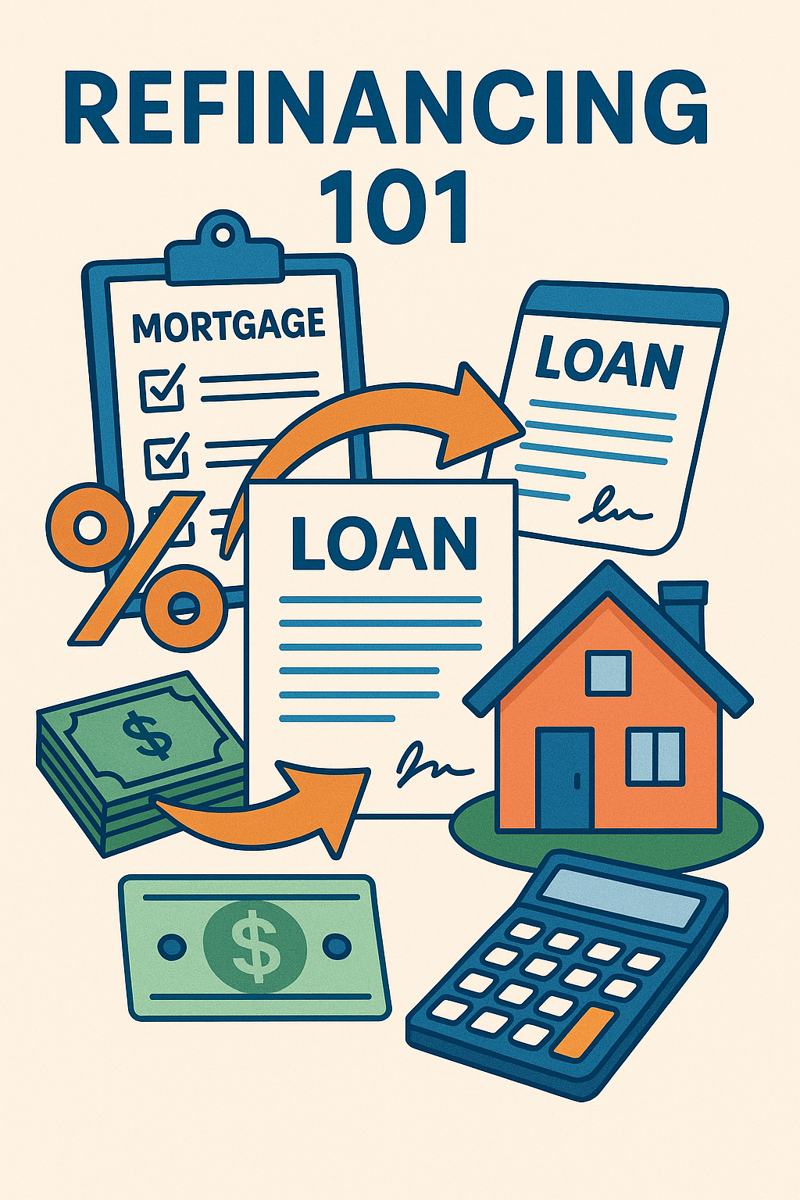Licensed in:
Refinancing 101: What You Need to Know Before You Start
If you’ve been hearing a lot about refinancing your mortgage, you’re not alone. With interest rates shifting, home values rising, and financial goals evolving, many homeowners are taking a second look at their mortgage and wondering if they could be...

If you’ve been hearing a lot about refinancing your mortgage, you’re not alone. With interest rates shifting, home values rising, and financial goals evolving, many homeowners are taking a second look at their mortgage and wondering if they could be doing better.
Whether you’re looking to lower your monthly payments, tap into your home’s equity, or just get on a faster path to paying off your loan, refinancing can be a smart move. But before you jump in, it’s worth understanding what refinancing actually is, how it works, and what you should consider along the way.
What Does It Mean to Refinance?
Refinancing simply means replacing your current mortgage with a new one. The new loan pays off the old one, and you start making payments under the new terms.
You can refinance with your current lender or a new one. The key is that you’re not adding a second loan, you’re restructuring your original one.
There are generally two types of refinancing:
1. Rate-and-term refinance:
This is when you want to lower your interest rate, change the length of your loan term (for example, from 30 years to 15), or switch from an adjustable-rate to a fixed-rate mortgage.
2. Cash-out refinance:
This option lets you borrow more than you currently owe, using your home’s equity. You get the difference in cash, which you can use for anything from home improvements to paying off debt.
When Does Refinancing Make Sense?
Refinancing isn’t right for everyone, but here are a few situations where it might be a smart financial move:
- Interest rates have dropped: Even a one-point decrease in your rate can save you thousands over the life of the loan.
- Your credit score has improved: A stronger credit profile can help you qualify for better terms than when you first bought your home.
- You want to switch loan types: Moving from an adjustable-rate mortgage to a fixed-rate loan can provide stability, especially in uncertain rate environments.
- You want to access home equity: Whether you need to consolidate debt, fund renovations, or cover unexpected costs, a cash-out refinance can give you access to the money tied up in your home.
What’s the Catch? Costs and Considerations
Refinancing isn’t free. Like your original mortgage, you’ll need to go through an application and underwriting process, and there are closing costs to consider. Usually 2% to 6% of your loan amount.
Here are a few other things to keep in mind:
- Break-even point: This is how long it will take for your monthly savings to cover the cost of refinancing. If you’re not planning to stay in your home long enough to hit that break-even point, refinancing might not make sense.
- Loan term reset: If you’ve been paying on your mortgage for years, refinancing into a new 30-year loan could mean paying more interest in the long run, even if your rate is lower.
- Private mortgage insurance (PMI): If your new loan is more than 80% of your home’s value, you may need to pay PMI, even if you didn’t have it before.
What Do Lenders Look For?
You don’t need perfect credit to refinance, but lenders will still want to make sure you’re in a good position to take on a new loan. Here’s what they usually consider:
- Credit score: Generally, the higher your score, the better your terms — but many lenders work with borrowers in the 600s or even high 500s, depending on the loan type.
- Debt-to-income ratio (DTI): This compares how much you owe each month to how much you earn. Most lenders prefer a DTI under 43%, though some programs allow for more.
- Equity: For a cash-out refinance, most lenders want to see that you still have at least 20% equity remaining after the refinance.
Refinancing With Less-Than-Perfect Credit
If your credit score isn’t where you want it to be, don’t assume you’re out of options. There are refinancing programs available for homeowners with fair credit, and FHA refinance options may offer more flexibility.
It also may be worth doing a bit of credit cleanup before applying, paying down revolving debt, correcting errors on your credit report, or avoiding new credit inquiries for a few months.
A good lender will walk you through your options, not push you into something that doesn’t make sense for your goals.
The Bottom Line
Refinancing can be a powerful tool, whether you’re looking to lower your monthly payments, eliminate debt, or make the most of your home’s equity. But like any financial decision, it’s not one-size-fits-all. The right refinance depends on your goals, your timeline, and your current financial picture.
Before making any decisions, talk with a trusted lender who can break down your numbers and help you make sense of your options.
At Neighborhood MC, we are excited to help you with your mortgage needs. No challenge is too great for us.